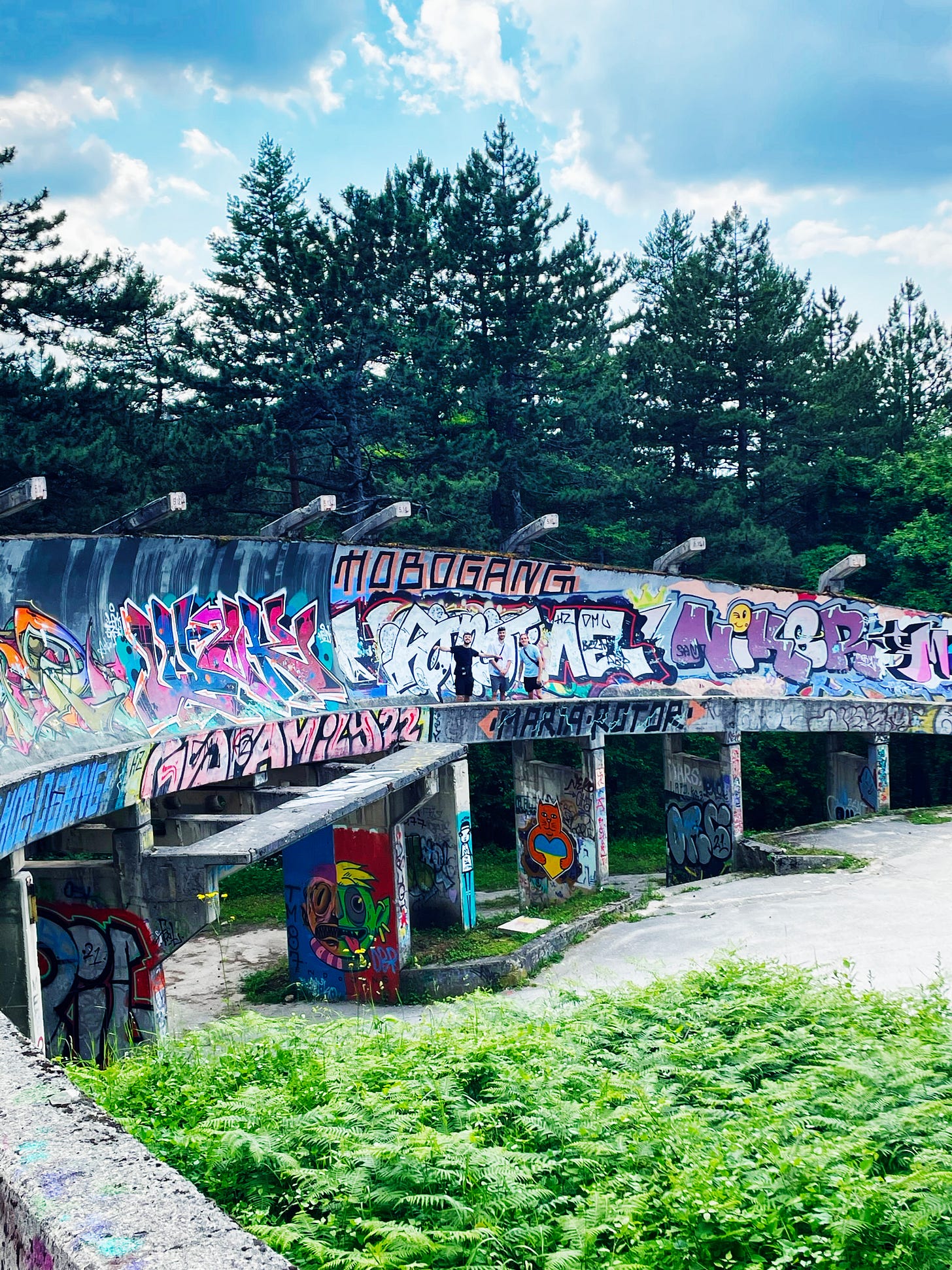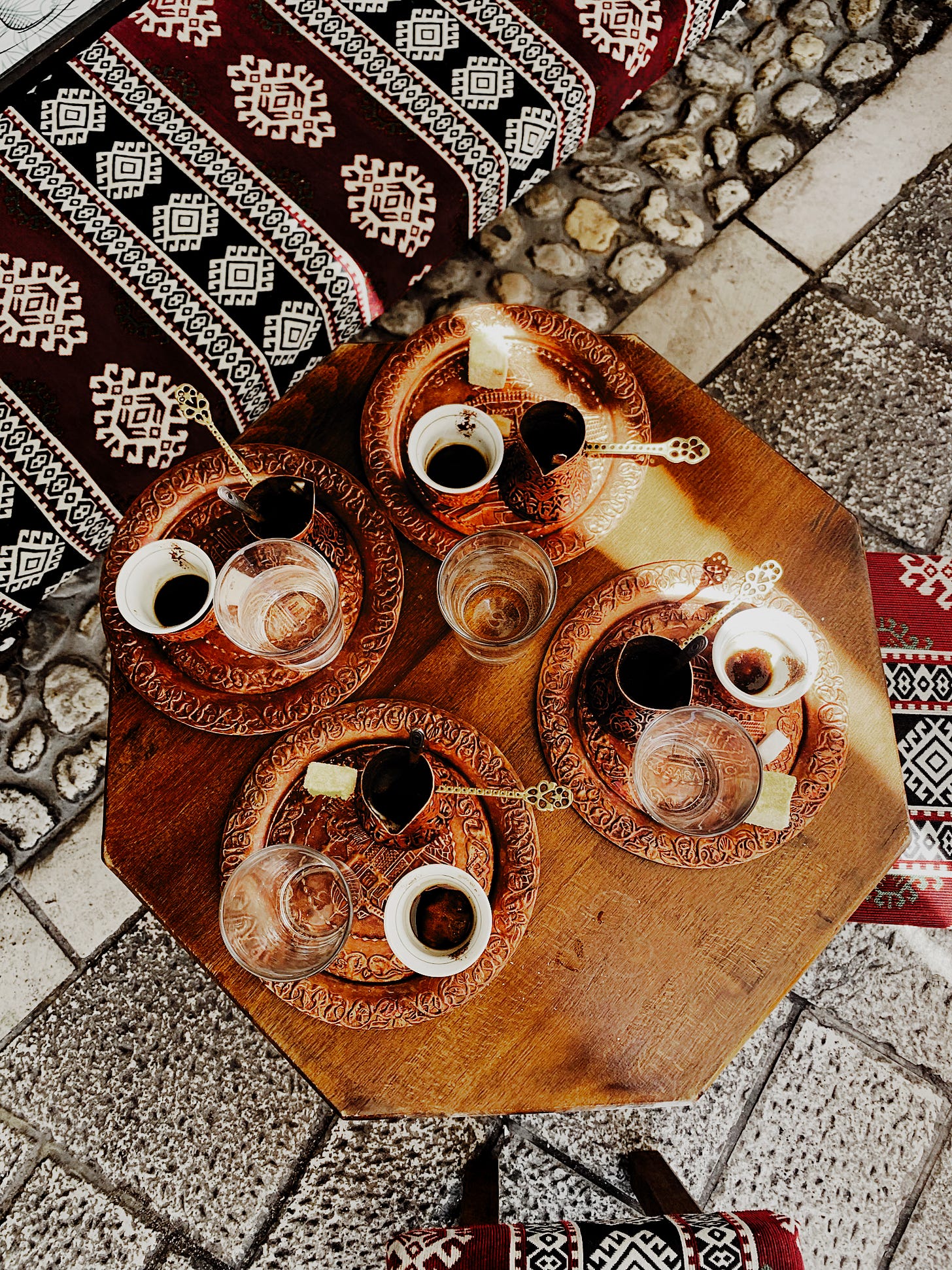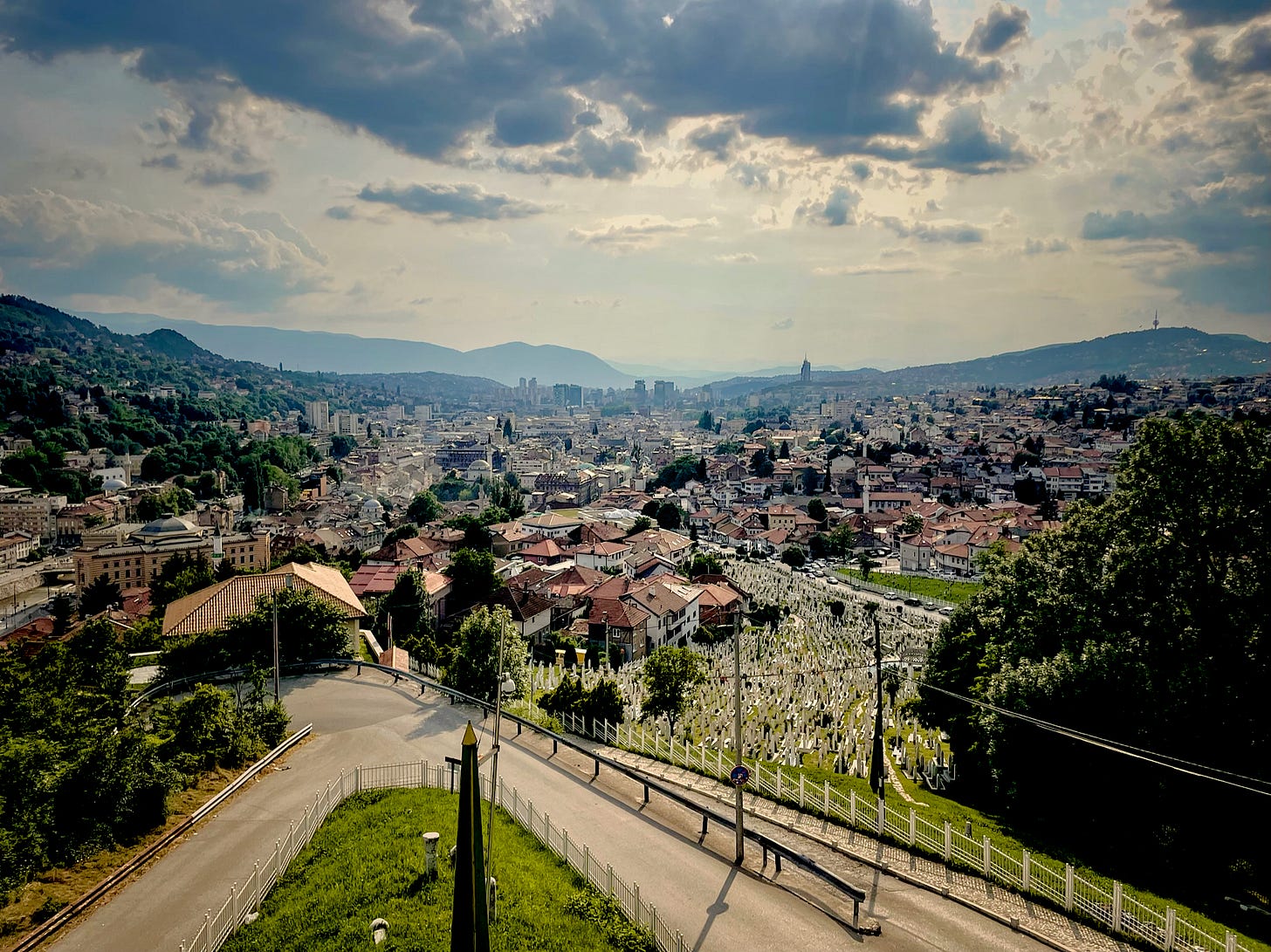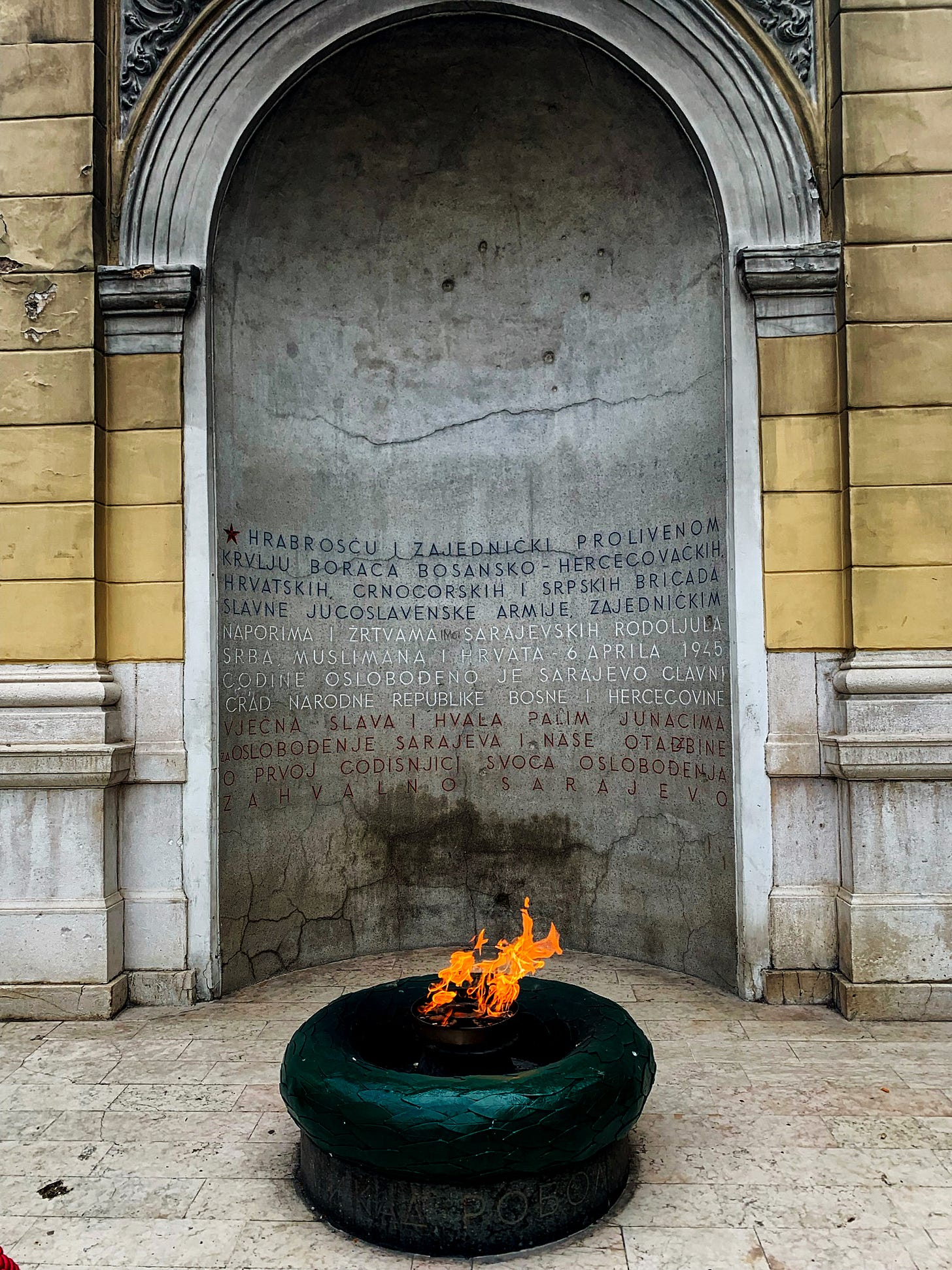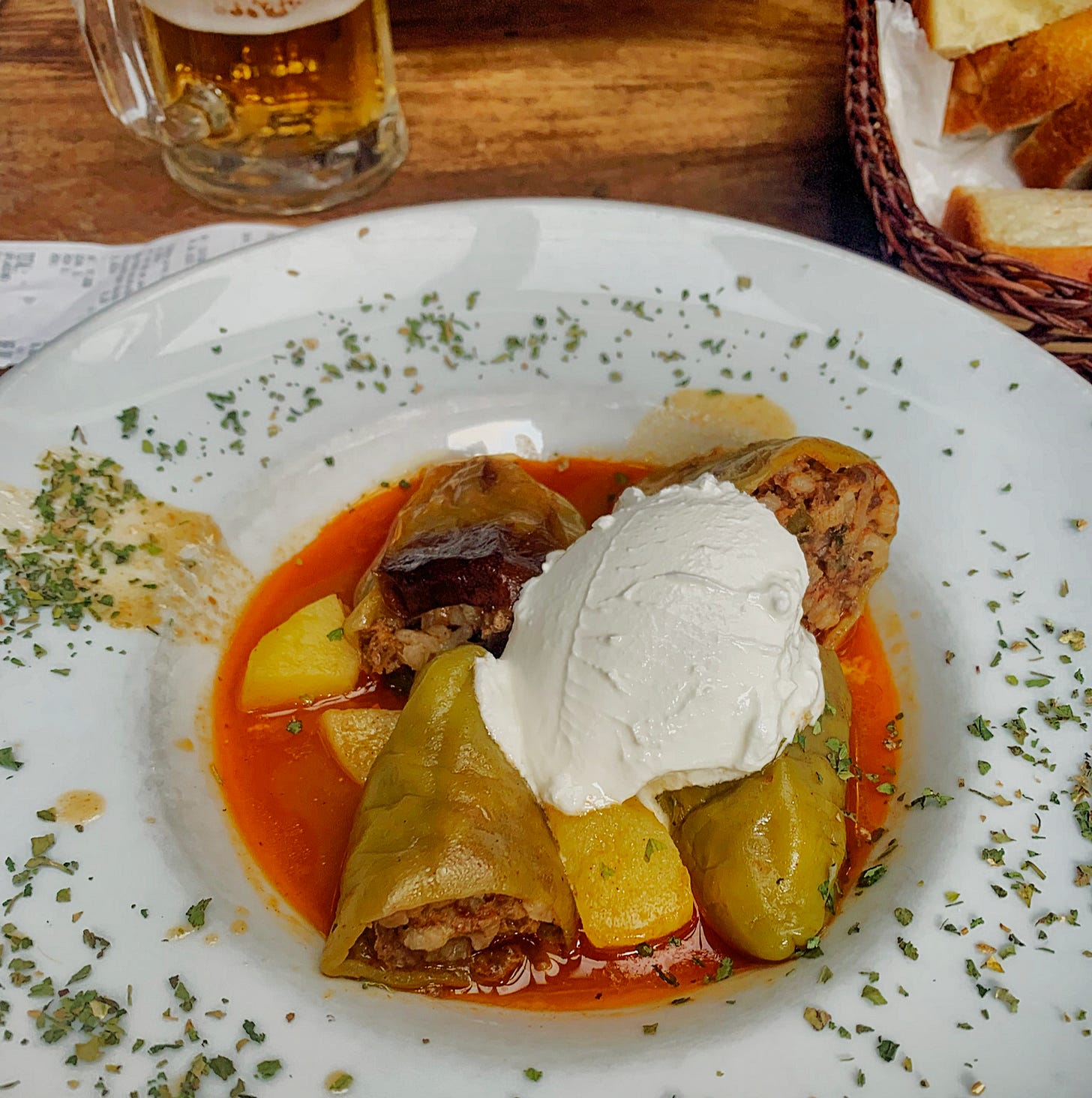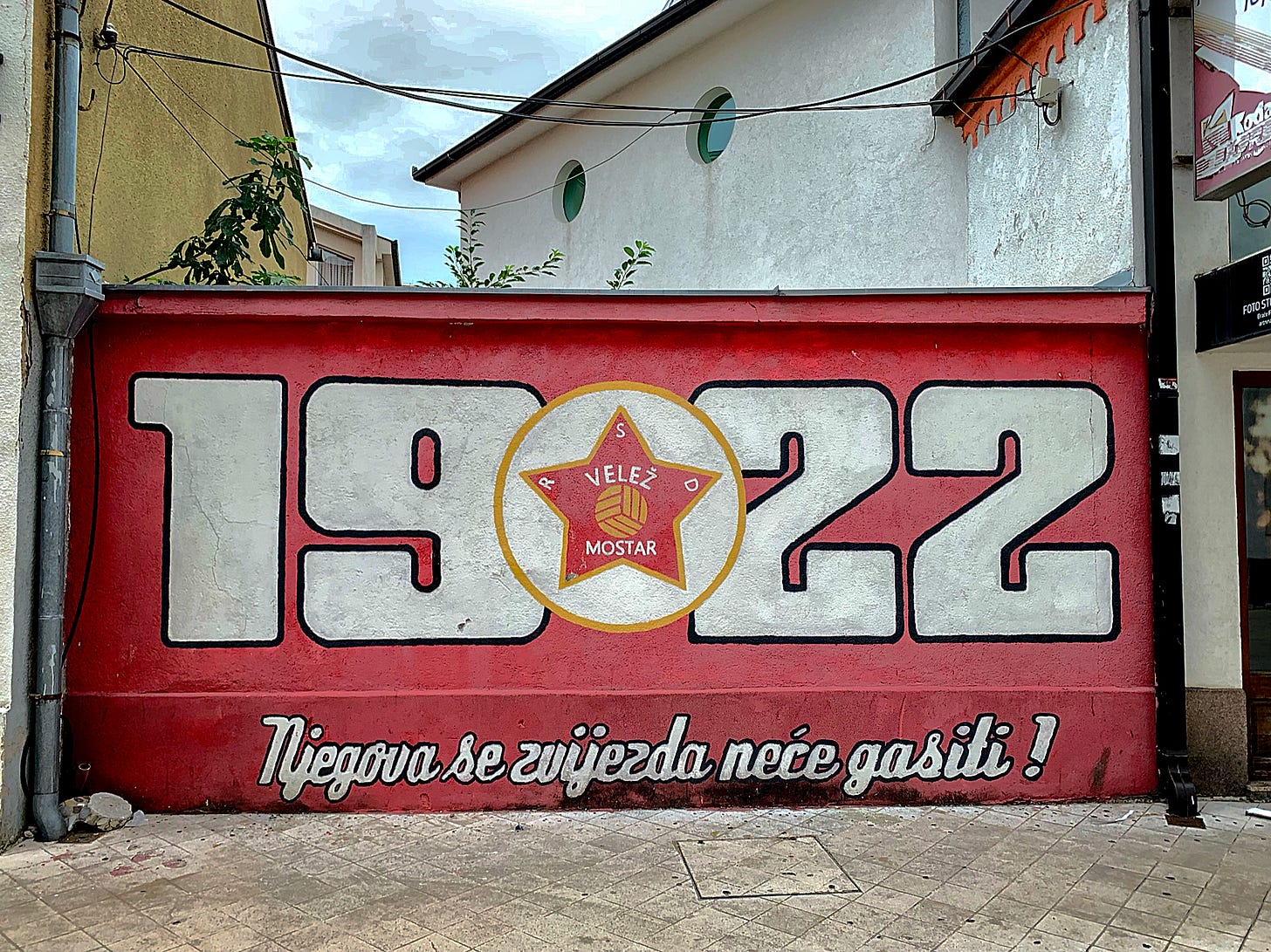"Game of Bones" in Sarajevo
Black Butterflies, bitter coffee, stuffed peppers & hope | The Academy Briefing | MUFC trivia | Steve Coogan and a Chorlton walking tour
If you’re new here: I’m Harry Robinson, a 23-year-old Stretford Ender, freelance football journalist and the author of The Men Who Made Manchester United. I write about things I’m passionate about, mainly MUFC, history, youth football and travel.
What’s inside:
Sarajevo (Black Butterflies, Game of Bones, Tunnel of Hope and stuffed peppers)
MUFC trivia (Yugoslav teams)
The Academy Briefing (U18s stay unbeaten, U21s Manchester derby)
What I’ve enjoyed this week (Steve Coogan, Chorlton walking tour)
1: Sarajevo
I read Black Butterflies by Priscilla Morris last week. You should read it, too. It’s about Sarajevo, and so is this…
“Croatia has Game of Thrones, we have Game of Bones.”
So summarised Mustafa, the Bosnian who showed us his city, Sarajevo. I’ve thought about him and his home very regularly since visiting last summer.
I was born after the various Yugoslav wars had ended. My limited knowledge of them came primarily through footballing events like Bosnia & Herzegovina’s appearance at the 2014 World Cup, the controversy around Adnan Januzaj’s choice of international team and Xherdan Shaqiri’s dove celebration.
So recent were these wars that they weren’t included, or even mentioned, on any school syllabus. My only earlier exposure to what happened came through United fans’ song for Nemanja Vidic, a Serb: “He’ll fucking murder ya.”
Then I came across photos of Sarajevo’s abandoned 1984 Winter Olympics bobsleigh track, an enticing location.
I was making plans to do so on an interrailing trip which coincided with Euro 2020. Those plans were scuppered and replaced by a similar holiday three years later. I’m so glad I eventually went and if you take only one recommendation from me, make it this one: go to Sarajevo!
Framed by vivid green mountains, it’s a beautiful city, in parts. The restored old town feels magical, especially when the sun glints off the dark golden trays carrying bitter Bosnian coffee and illuminates the curved mosque roofs.
That’s not what you see when you are dropped into the middle of a pack of stray dogs on the side of the road. That was our fate at 6am after an overnight coach from Belgrade which stopped every hour and ended with a hairy, swerving ride through mountain roads at breakneck speeds. On a damp, grey morning, we navigated past the dogs and trudged along a road only half-built. Or half re-built, I should say. The buildings on its right side had holes in them made by bullets or bombs. It was some first impression.
Unable to enter our hostel due to the early hour, we sat in the nearest café and had our first taste of Bosnian hospitality. Nothing can warm you up better than that. Our host was a rectangular-shaped bearded man who’d have suited a Roman chariot race. Like every Bosnian we met, he was thrilled to welcome visitors and the perfect tonic to a torturous journey.
“Croatia has Game of Thrones, we have Game of Bones.”
In Croatia, tourists are plentiful. The industry has transformed the country. Bosnia has not marketed itself as successfully. Whereas Croatia is now associated with beaches and beauty, ‘Bosnia’ still evokes images of war and hardship. That’s why they’re happy to see you.
I’d spent the previous couple of weeks reading The Fall of Yugoslavia by Misha Glenny, an incredible book. Suddenly it was all coming to life. No one could make it come to life better, though, than Mustafa. If you go, do his tour.
Sarajevo has always been a remarkable place. As the meeting point of East and West, it’s an incredible mix of cultures, as evidenced by its religious buildings, the spices and ingredients in its food and its culture.
And then, the siege happened.
The Siege of Sarajevo, in brief: The longest blockade of a capital city in the history of modern warfare, lasting from 5 April 1992 until 29 February 1996. A total of 13,952 people were killed — 5,434 civilians — during the siege, while the population of the city — who spent six months without gas, electricty or water supply — decreased by up to 200,000. Four Serb officials were convicted for crimes against humanity. It could have been many more.
Looking down over the city from a point where Serbian snipers would pick off civilians, Mustafa recalled his first emotions when war was declared. He was 13. “Can this last forever?” he thought. There was no school!
Seven or eight months in, the novelty had worn off. School restarted, in basements and abandoned buildings. The location changed every day.
Everyone trapped inside Sarajevo soon learnt “the art of living.” Those in the valley had a little water but no gardens. They ate nettle soup. Those on the hillsides had gardens but no water. Rainwater was used for showers.
All these experiences are captured with the most intense emotion in Black Butterflies, which I urge you to read. The stories inside, combined with Mustafa’s, stick with me. The sadness, absolutely, but also the ingenuity and community in the face of evil.
Mustafa and his brother, for example, made a generator from two bike pedals, a leather belt, a windscreen wiper and the engine of an abandoned car (gasoline had run out). Each bike pedal could generate six volts. Twelve volts together could power a tiny black and white TV on which they could watch an equally tiny variety of films.
Meanwhile, up in the hills, rich foreigners — including Brits — would be crouched waiting to shoot down civilians as if it were a video game. They paid the Serbs for the right to do so. I’ve never heard of such callous wickedness.
Go yourself, if you can, and hear these stories first-hand because that’s what’s so extraordinary about Sarajevo. On the same interrailing trip, we went to Auschwitz and the factory of Oskar Schindler. They are powerful places, yes, but not like Sarajevo, where when you walk down the street, you know every stranger you walk past over the age of 30 experienced that horror. And they came out the other side. It fills you with hope.
Quick recommendations for Sarajevo:
Visit the Galerija 11/07/95 which has the most haunting and impactful images and aural history telling the story and trying to explain the Srebrenica massacre
Eat the stuffed peppers!
Go up the cable car and walk down the abandoned bobsleigh track
Take the train to Mostar (and sit on the left-hand side for amazing views in the final 20 minutes of the journey)
Mostar has a famous old 16th-century bridge (Stari Most) which was bombed during the war
People jump off the bridge, which is 24 metres above the shallow river. Watch, but do not try.
It became a truly divided city
Mostar also had an old bazaar, another couple of great bridges, a statue of Bruce Lee (yes, really) and some great food.
There are two football teams in Mostar. HSK Zrinjski Mostar were founded by young Croats in 1905 when Mostar was part of the Austro-Hungarian empire. Having participated in the Croatian league during World War Two, they were banned from competing in the Yugoslav league from 1945. They reformed when Bosnia gained independence and are supported primarily by Croats. The club is used as a vehicle for Croatian nationalism, supported by the main Croat political party in Bosnia.
Zrinjski’s rivals are FK Velež Mostar, who are primarily supported by the ‘Bosniaks’. Velež have an admirable history of anti-fascism.
Graffiti for both teams can be found all over Mostar, alongside the thousands of graves which leave a lump in your throat.
2: MUFC trivia
How many times did Manchester United play against teams from Yugoslavia?
3: The Academy Briefing
Under-21s
Goals from Ethan Wheatley and player-coach Tom Huddlestone gave United a 2-1 derby victory over Manchester City on Monday night. Travis Binnion’s team did well to hold on for 20 minutes after Sam Mather’s 79th-minute red card. There were 11 minutes of added time. Having lost 6-0 when the sides last met (March 2023), this will be a satisfying result for the players and staff.
Under-18s
United remain unbeaten in the U18 Premier League after a 2-2 draw at Nottingham Forest. Gabriele Biancheri had United two in front, scoring the first and forcing the second, an own goal. Harry Amass delivered an excellent free-kick cross for the second.
Forest responded immediately, Danny Anijsko with a wonderful bit of skill to set it up and equalised through ex-Red Adam Berry in the second half.
This week
No U21s game — although they’ve organised several friendlies against senior opposition recently, such as Oldham Athletic, so may do so again — but the U18s are in action. They host Middlesbrough at midday on Saturday. That’ll be live on MUTV.
4: What I’ve enjoyed recently
The ‘Secrets of Chorlton’ walking tour, run by Jonathan Schofield. He only runs this Chorlton one twice a year, but there are plenty across Manchester and this one was good. My favourite story was of a famous fat man from Didsbury who toured the city to perform his trick. The trick? Drinking a quart of buttermilk, getting spectators to put an ear to his enormous belly and then eating baby potatoes so they could hear them splash inside his stomach. So that’s what they did before the internet!
This video of Steve Coogan on the BBC Archive
That’s all for today. Thanks for reading. If you’ve enjoyed this, feel free to share it with a mate. Have a great rest of your week!
5: MUFC trivia answers
How many times did Manchester United play against teams from Yugoslavia?
Seven.
Two-legged ties against Red Star Belgrade in 1958, Partizan Belgrade in 1966 and Sarajevo in 1967 before a one-off match against Red Star in the 1991 European Super Cup.

